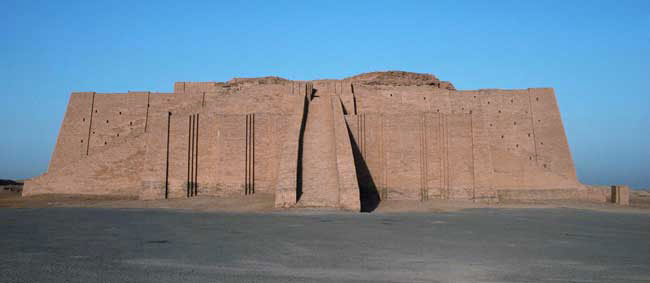Science and Technology
Writing was only of the many advances credited to the ancient Mesopotamians. By developing a variety of tools and techniques, the Mesopotamians were the first to make a prosperous living based on large-scale agriculture. The earliest and, perhaps, most significant development came in the fourth millennium BCE, when a Sumerian crafter built the first known wheeled vehicle. The design, using solid wooden wheels, allowed oxen to pull three times as much weight as before. Aside from the use of wheeled vehicles, Mesopotamian farmers developed seeder-plows and pickaxes to make their work easier and more efficient. The Mesopotamians became talented bakers,brewers, weavers, and tanners. Some of their buildings, constructed of mud-brick and tile, were so well built that they survive today.
Beliefs
Mesopotamian religion is the oldest in the world for which written records exist. It was a polytheistic religion comprising some 3600 various gods and demigods. This vast number of deities reflects the diversity from region to region. Despite the differences in the representation of the gods and the varieties found in the local towns, all of Mesopotamia shared essentially the same religion. The five most prominent deities were Enlil, the supreme god and god of the air, Ishtar, the mother goddess of fertility and life; An, the god of heaven; Enki, the god of the underworld and the water; and Shamash, the sun god and the giver of law. The names used here are Sumerian. Throughout Mesopotamian history, the names would change but the basic functions remained the same.

Ziggurats: Temples to the Gods
According to the beliefs of the ancient Mesopotamians, it was vitally important that the gods be honored by religious ceremonies. These ceremonies were performed by the priests in sacred temples. Like most Mesopotamian architecture, temples were constructed of mud brick. Constant threat of flooding meant that the temples had to be placed on platforms. Over time, the temples evolved into the imposing structures known as ziggurats. This was a stack of platforms decreasing in size from bottom to top. The structure resembled the step pyramids of the Egyptians except that a small chapel sat on t top of the ziggurat. Ziggurats ranged from one to seven platforms and were decorated with painted stucco and colored, glazed bricks. To further enhance their appearance, the structures were often planted with flowers, shrubs. and trees.
One of the most famous ziggurats was the Tower of Babel. The original structure was destroyed and rebuilt several times. The final restoration was undertaken by Nebuchadnezzar, who hoped to raise the tower up to heaven. Once completed, the Tower of Babel was called one of the great wonders of the ancient world. This ziggurat's temple was perched almost 100 m above around. The base measured 91 m on each side and covered half a square kilometre. Surrounding the massive structure were storehouses and apartments for the priests who served the temple.

The Ziggurat of Ur was built ca. 2000 BCE
Writing: ECHOES from the Past published by McGraw-Hill Ryderson Ltd.
No comments:
Post a Comment